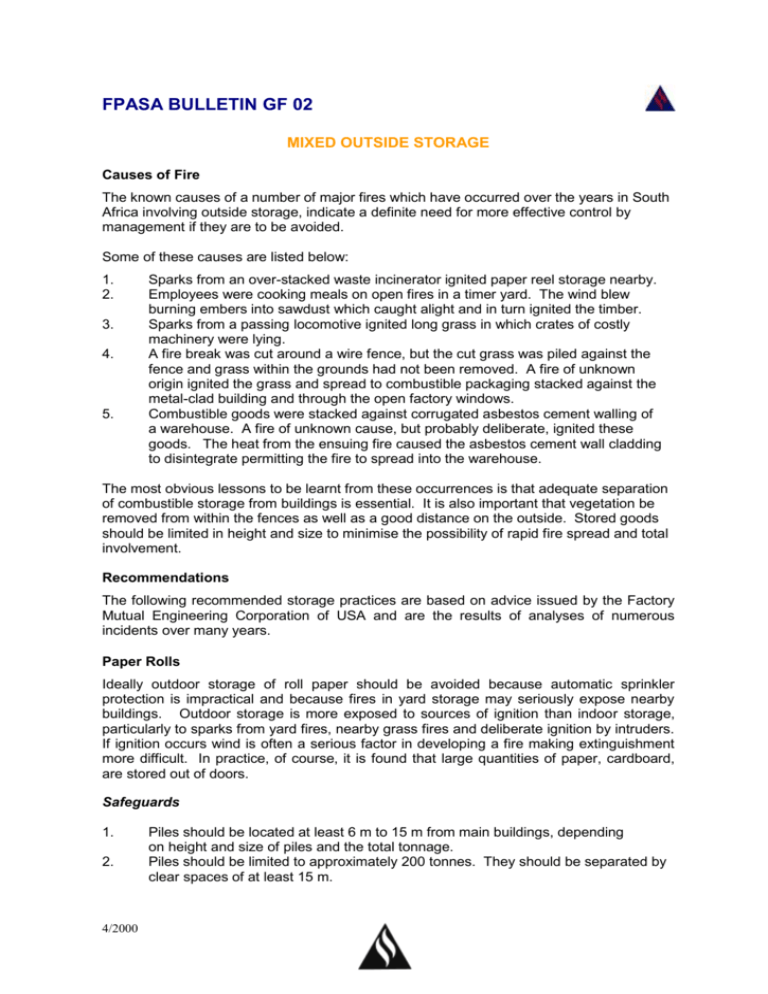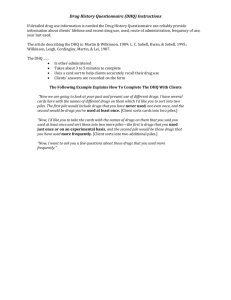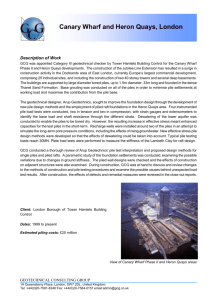Mixed outside Storage
advertisement

FPASA BULLETIN GF 02 MIXED OUTSIDE STORAGE Causes of Fire The known causes of a number of major fires which have occurred over the years in South Africa involving outside storage, indicate a definite need for more effective control by management if they are to be avoided. Some of these causes are listed below: 1. 2. 3. 4. 5. Sparks from an over-stacked waste incinerator ignited paper reel storage nearby. Employees were cooking meals on open fires in a timer yard. The wind blew burning embers into sawdust which caught alight and in turn ignited the timber. Sparks from a passing locomotive ignited long grass in which crates of costly machinery were lying. A fire break was cut around a wire fence, but the cut grass was piled against the fence and grass within the grounds had not been removed. A fire of unknown origin ignited the grass and spread to combustible packaging stacked against the metal-clad building and through the open factory windows. Combustible goods were stacked against corrugated asbestos cement walling of a warehouse. A fire of unknown cause, but probably deliberate, ignited these goods. The heat from the ensuing fire caused the asbestos cement wall cladding to disintegrate permitting the fire to spread into the warehouse. The most obvious lessons to be learnt from these occurrences is that adequate separation of combustible storage from buildings is essential. It is also important that vegetation be removed from within the fences as well as a good distance on the outside. Stored goods should be limited in height and size to minimise the possibility of rapid fire spread and total involvement. Recommendations The following recommended storage practices are based on advice issued by the Factory Mutual Engineering Corporation of USA and are the results of analyses of numerous incidents over many years. Paper Rolls Ideally outdoor storage of roll paper should be avoided because automatic sprinkler protection is impractical and because fires in yard storage may seriously expose nearby buildings. Outdoor storage is more exposed to sources of ignition than indoor storage, particularly to sparks from yard fires, nearby grass fires and deliberate ignition by intruders. If ignition occurs wind is often a serious factor in developing a fire making extinguishment more difficult. In practice, of course, it is found that large quantities of paper, cardboard, are stored out of doors. Safeguards 1. 2. 4/2000 Piles should be located at least 6 m to 15 m from main buildings, depending on height and size of piles and the total tonnage. Piles should be limited to approximately 200 tonnes. They should be separated by clear spaces of at least 15 m. 3. 4. 5. 6. 7. 8. 9. 10. Roll paper in the yard should be stored on side rather than on end. The arrangement generally results in less intense fire because there is less tendency for the rolls to unwind and the flue effect between stacks is reduced. Height of piles should be limited to about 5 m. The entire storage area should preferably be paved or otherwise kept free of dried grass, debris and weeds, and should be protected against unauthorised entry. Concrete slab fencing is preferable to wire mesh. A clear space of at lest 15 m should be maintained between public ways and piles. Hydrants and hose protection should be provided. Hydrants should be located so that no part of the storage area is more than 60 m from a hydrant. A regularly recorded watch service should be provided to cover the entire area. First class housekeeping should be maintained throughout the storage area. Smoking should be prohibited and other ignition sources eliminated from the vicinity of the storage area. Spark arresting equipment should be installed on stacks from incinerators, locomotives and other spark producing equipment. Waste Paper Economic considerations dictate that large quantities of waste paper be stored outside. Safeguards 1. 2. 3. 4. 5. 6. Piles of waste paper should be located from 6 m to 15 m from important buildings and plant facilities. Small piles one bale high are acceptable as close as 6 m with larger piles containing several hundred tonnes and 5 m to 6 m high, the 15 m distance is needed Piles should be located at a safe distance (at least 15 m) from public ways, incinerators, and other sources of ignition. Separate piles by at least 15 m of clear space. Keep the entire storage area free of dried grass and weeds and protected against unauthorised entry. Limit piles size to 750 tonnes (preferably to 500). Limit pile height to 6 m. Coal The storage method does much to determine whether spontaneous ignition will occur. The following suggestions have been developed from experience and are applicable to most manufacturing plants. 1. 2. 4/2000 Avoid storing the coal in contact with any course of external heat such as piping, flues, and boiler walls, and over steam mains even though buried. Limit the height of the pile. Low grade coal should not be piled higher than 3 m and best grade not higher than 5 m, unless it is piled by the roll packing method. Roll packed piles should generally be limited to 6 m in height. If large capacity coal handling equipment is available at all times somewhat higher roll packed piles are allowable. High piling makes it difficult to reach any heating that occurs. Piles should be located a safe distance from other combustibles and from important plant buildings and equipment. Cotton bales If temporary outdoor storage of cotton bales is necessary the following measures are recommended. 1. 2. Outside stored bales should be the first ones to be used. Outside storage piles should be limited to 500 bales per pile with a clear space of preferably 15 m but not less than 10 m between individual piles and between piles and buildings. Piles three to five metres high are convenient for handling and for weather covering. Adequate hydrants and hoses should be provided to protect the outside storage. Remove dead grass and loose combustible materials in the vicinity of the piles. Institute an effective security system. Lower bales should be placed on dunnage to provide ventilation and prevent excess damage by ground moisture. 3. 4. 5. Sprinkler Protected Buildings The Automatic Sprinkler Inspection Bureau, which inspects sprinkler installations for insurance discount purposes, has issued the following ruling regarding the minimum distance of combustible storage from sprinklered buildings: The distance between stacks of materials and buildings should be at least equal to the stack heights. For buildings of inferior construction, drenchers would be required below the eaves to protect the exposed face, but, where standard construction exists, only openings (windows and doors) need have cut-off drenchers. Wood Products A fire once established ins tacked timber is one of the most formidable with which firefighters have to contend. Intense radiant heat makes approach difficult and dangerous and seriously exposes surrounding property. Under unfavourable wind conditions burning brands can start secondary fires considerable distances away. It is important that fire in a timber yard be discovered and attacked without delay while still small. For this purpose an effective watch service, alarm system and a sizeable wellequipped and well-trained fire organisation is essential. For effective performance there should be close co-operation and advance planning between public and plant fire protection personnel. Containing a timber yard fire requires large quantities of water. It is important that there are sufficient hydrants connected to a reliable water supply with sufficient hoses to deliver the water where it is needed. Careful attention to housekeeping and the elimination of ignition sources will reduce the chance of fire starting. Reasons for fire spread in storage yards delayed discovery delayed fire-team response inadequate water supplies – large volumes are necessary for controlling and extinguishing fires involving wood products lack of hydrants undivided piles and congested storage poor fire-fighting techniques and access difficulties 4/2000 4/2000 Yard layout for forest products solid ground surfaced with fine gravel or stone stacking in a consistently orderly manner a maximum stack-height of 6 m as a guide to the size of stacks, no part should be further than 15 m from a fire lane, ie: lanes permitting the passage of fire vehicles demarcating posts to limit stack sizes and indicate boundaries of stacks protection of buildings in the vicinity of the yard either by separation, fire-resisting construction, or by drencher systems. Wood chip piles should preferably be limited to 15 m in height. This pile is too large and if alight, would be almost impossible to control. Poles & posts These are usually stacked in ranked piles or in crib formation. Flat crib style stacking without any space between stacks -–so forming solid packed rows – require unobstructed alleys of 1,5 m width which permits fire-fighters access with hand-held hoses. Open stacks which would allow hose streams to penetrate need only have an aisleway every alternate row of post stacks. Where it is not practical to provide aisleways of 1,5 m width between each row, the length of the rows should be reduced by 20 % - 50 % to reduce fire loading and to facilitate fire-fighting. Treated posts and poles should not be stored in the same stacks as untreated products. Separation distances of at least 30 m will reduce the possibility of fire spread from one such area to the other. Wood chips and wood waste material Additional controls to monitor spontaneous heating of piles may have to be employed. Surface and internal fires are a possibility and the internal pile temperature may require monitoring. 4/2000 Prevention of internal pile fires avoid burying refuse and old chips in the pile base prepare a clean, hard surface before starting a pile regular reclamation of the piles – the period will vary depending upon climatic conditions and pile contents limitation of pile size. Several small piles are safer than one large pile. Special consideration to the pile height, especially if fine materials are stored in the pile and are subjected to compaction. For example, wood chip piles should preferably be limited to 15 m in height. monitor internal pile temperatures regularly during pile build-up fines present the most serious hazard during building up of the pile – their concentration should be controlled. Consideration for protecting piles narrow piles are easier to extinguish and maximum dimensions should ideally be 19 m high 90 m wide and 150 m long. piles exceeding 150 m in length should be sub-divided by fire lanes of at least 9 metres wide low barrier walls will aid in defining the pile boundaries combustible conveyors and elevated enclosed conveyors feeding the pile should be protected by sprinklers Logs and lumber These are usually stored in ranked (evenly arranged) piles and separated by aisleways with a width of either 6 m or 1½ times the height of the pile. Fire breaks 30 m wide between alternate rows of pile groups and pile lengths not exceeding 150 m, will assist firefighters access. Water Supplies hydrants a maximum distance of 60 m apart at aisleway intersections so that 2 lengths of hose will reach any area of the yard (see photo). If stacks obstruct the hydrants, elevated markings on poles showing hydrant location should be utilised. water requirements are based upon 4 x 65 mm hose lines being used simultaneously with a residual mains pressure of 140 kPa. A combined flow of 4 500 l/min should be expected with supplies sufficient for 6 hours. 4/2000 Crib stacking of lumber in this scene creates an unnecessary exposure hazard to the timber-clad buildings. Also the sprinkler system feed pipe will be at risk of collapse or damage in the event of fire Safeguards the premises should be adequately fenced to keep out intruders spark arresters should be installed on any spark producing chimneys in the vicinity of timber yards the burning of rubbish or open fires for cooking should be strictly forbidden extinguishers should be provided on fork lift trucks and other power driven equipment good housekeeping essential – regular cleaning of materials ie: handling equipment, removal of combustible waste (bark, sawdust, chips) etc. Remove grass, weeds and rubbish in the yard and on the boundaries no smoking enforced except in designated safe areas – away from mills and yard. Protection of exposures separate yard areas and operations. Separation distance depends upon severity of the risk which varies according to area, height and occupancy, construction and the type of stacking. separation of piles and stacks from each other and plant buildings should prevent fire spread through radiated heat, but flying brands can still spread fire. One or more of the following may protect plant buildings and reduce fire spread - barrier walls to protect buildings - perimeter stacking equivalent to a barrier wall, ie: materials of greatest thickness and green stock - drencher systems especially designed to protect exposed structures Fire detection and extinguishing considerations early detection vital, placing the emphasis on regular watchman patrols and an alarm system. Extra patrols during dry weather should be considered establishment of a trained fire-team and regular drills to maintain competency is vital 4/2000 procedures practised for notifying fire brigade and plant fire-teams. In remote areas an alarm linked to the mill’s township might result in quicker response of additional fire teams – if pre-planned easy access to fire lanes for fire-fighting vehicles maintain fire-fighting equipment and keep records of standard tests. Replacement equipment should be readily available and all designated fire-fighting equipment must be used for that purpose only. Too often hose-reels and fire hose are used for washing vehicles and other extraneous purposes, causing deterioration and damage. Good housekeeping, neat stacking, an adequate hydrant system properly demarcated, are features of this well manages log storage yard. Reference NFPA 46: Storage of forest product Published by: Fire Protection Association of Southern Africa (Incorporated Association not for Gain) (Reg.No. 73/00022/08) P O Box 15467 Impala Park 1472 4/2000






